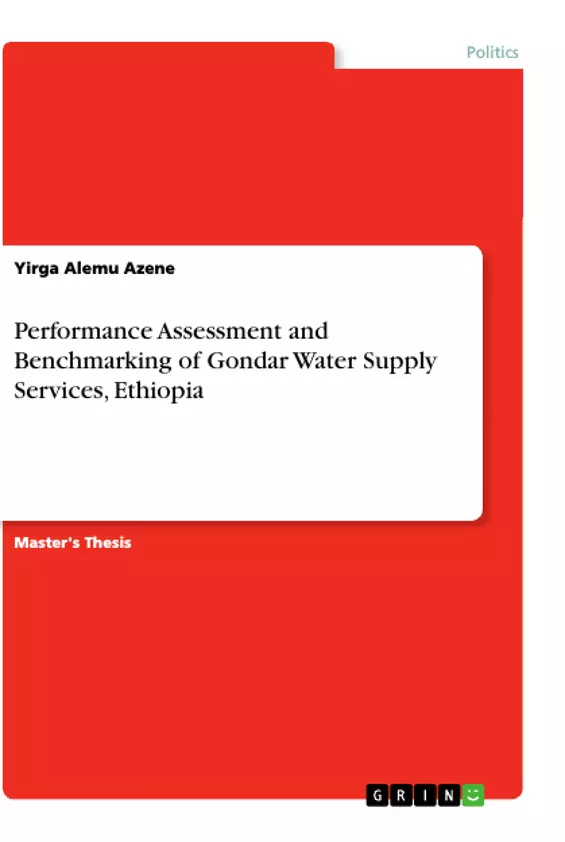The main objective of the study is to establish the performance of GWSSS in terms of quality of water services, economical
efficiency, and operational sustainability against widely accepted key standard performance indicators and benchmarking the water utility against other well-performing utilities around East Africa for purposes of development of decision support tools for better management of the system.
The last eight-year data from the annual report and from the management information system of the Gondar utility are used in the analysis of indicators and to see the performance trend. Performance evaluation of water supply services for Gondar city was carried out using thirteen key performance indicators. From the first category six indicators in the quality of water services, one indicator on water quality compliance has the utility performing well. The other five indicators that are water supply coverage, average total per capita consumption, average per capita domestic consumption, continuity of piped water supply, and the number of persons per domestic connection are the performance of the utility is poor and much below the benchmarked utilities. From the second category of four indicators in improving economic efficiency one indicator in improving personnel expenditure has moderate performance; one indicator on tariff cost recovery has shown low performance, and two indicators in improving bill revenue collection efficiency and operating cost coverage are well performed. The third category of three indicators in improving operational sustainability; one indicator in staffing level is poor performance and two indicators in nonrevenue water and treatment capacity utilized the utility is performing well compared to benchmarked utilities.
In general, GWSSS is performing well in five indicators, moderate performance in one indicator, and the rest seven indicators the performance of Gondar is poor and much below the benchmarked utilities. Therefore, it is highly recommended that Gondar utility should take much focus on improving: the water supply services, water production, number of water connections, water consumption, tariff cost recovery, and staffing level.
Inhaltsverzeichnis (Table of Contents)
- CHAPTER ONE
- 1 INTRODUCTION
- 1.1 General
- 1.2 Background of the Study Area
- 1.3 Statement of the Problem
- 1.4 Objectives of the Study
- CHAPTER TWO
- 2 LITERATURE REVIEW
- 2.1 Background
- 2.2 The Benchmarking Concept
- 2.3 The Existing Benchmarking Framework for Water Supply and Sanitation
- 2.4 International Efforts in Water and Sanitation Benchmarking
- 2.5 Key Performance Indicators
- 2.6 Water Service Level to Promote Health
- 2.7 Overview of the Urban Water Sector Performance in Uganda
- CHAPTER THREE
- 3 METHODOLOGY
- 3.1 Research Design and Data Collection
- 3.2 Data Analysis
- 3.3 Definition and Methods of Calculation of Key Performance Indicators
- CHAPTER FOUR
- 4 RESULTS AND DISCUSSIONS
- 4.1 Water Supply Coverage
- 4.2 Average Total Per Capita Consumption
- 4.3 Average per Capita Domestic Consumption
- 4.4 Continuity of Piped Water Supply
- 4.5 Percentage of Treatment Capacity Utilized
- 4.6 Water Quality Compliance
- 4.7 Number of Persons per Domestic Connection
- 4.8 Non-Revenue Water
- 4.9 Revenue Collection Efficiency
- 4.10 Working Ratio (Tariff Cost Recovery)
- 4.11 Operating Cost Coverage
- 4.12 Personnel Expenditure (%)
- 4.13 Staffing level
- CHAPTER FIVE
- 5. SUMMARY, CONCLUSION AND RECOMMENDATIONS
- 5.1 Summary
- 5.2 Conclusion
Zielsetzung und Themenschwerpunkte (Objectives and Key Themes)
This thesis aims to assess the performance of Gondar Water Supply Services (GWSSS) in Ethiopia and benchmark its performance against international standards and best practices. The research focuses on evaluating the efficiency and effectiveness of GWSSS's operations, identifying areas for improvement, and providing recommendations for enhancing the quality and reliability of water supply services in Gondar.
- Performance assessment of Gondar Water Supply Services based on key performance indicators.
- Benchmarking of GWSSS's performance against international standards and best practices in water supply and sanitation.
- Identification of strengths, weaknesses, opportunities, and threats (SWOT) for GWSSS.
- Development of recommendations for improving the performance of GWSSS and enhancing the quality and reliability of water supply services.
- Contribution to knowledge and understanding of water supply performance and benchmarking practices in developing countries.
Zusammenfassung der Kapitel (Chapter Summaries)
- Chapter One introduces the research, presenting the background of the study area, Gondar City, and the statement of the problem, which highlights the need for an objective evaluation of GWSSS's performance. The chapter outlines the objectives of the study, which are to assess GWSSS's performance, benchmark it against international standards, and develop recommendations for improvement.
- Chapter Two delves into the existing literature on water supply and sanitation performance assessment and benchmarking. It explores the concept of benchmarking, the existing framework for water supply and sanitation benchmarking, and international efforts in this field. The chapter also examines key performance indicators (KPIs) used to evaluate water supply services and the relationship between water service levels and public health.
- Chapter Three outlines the research methodology employed in the study. It explains the research design, data collection methods, and data analysis techniques used to assess GWSSS's performance. The chapter also details the definition and methods of calculating the KPIs used in the evaluation.
- Chapter Four presents the results of the performance assessment and benchmarking analysis. It discusses the findings for various KPIs, including water supply coverage, per capita consumption, continuity of supply, treatment capacity utilization, water quality compliance, non-revenue water, revenue collection efficiency, working ratio, operating cost coverage, personnel expenditure, and staffing levels.
Schlüsselwörter (Keywords)
The main keywords and focus topics of the text include: water supply services, performance assessment, benchmarking, key performance indicators (KPIs), water supply coverage, per capita consumption, continuity of supply, treatment capacity utilization, water quality, non-revenue water, revenue collection efficiency, working ratio, operating cost coverage, personnel expenditure, staffing levels, SWOT analysis, recommendations for improvement, Gondar Water Supply Services (GWSSS), Ethiopia.
- Quote paper
- Yirga Alemu Azene (Author), 2019, Performance Assessment and Benchmarking of Gondar Water Supply Services, Ethiopia, Munich, GRIN Verlag, https://www.grin.com/document/945383



